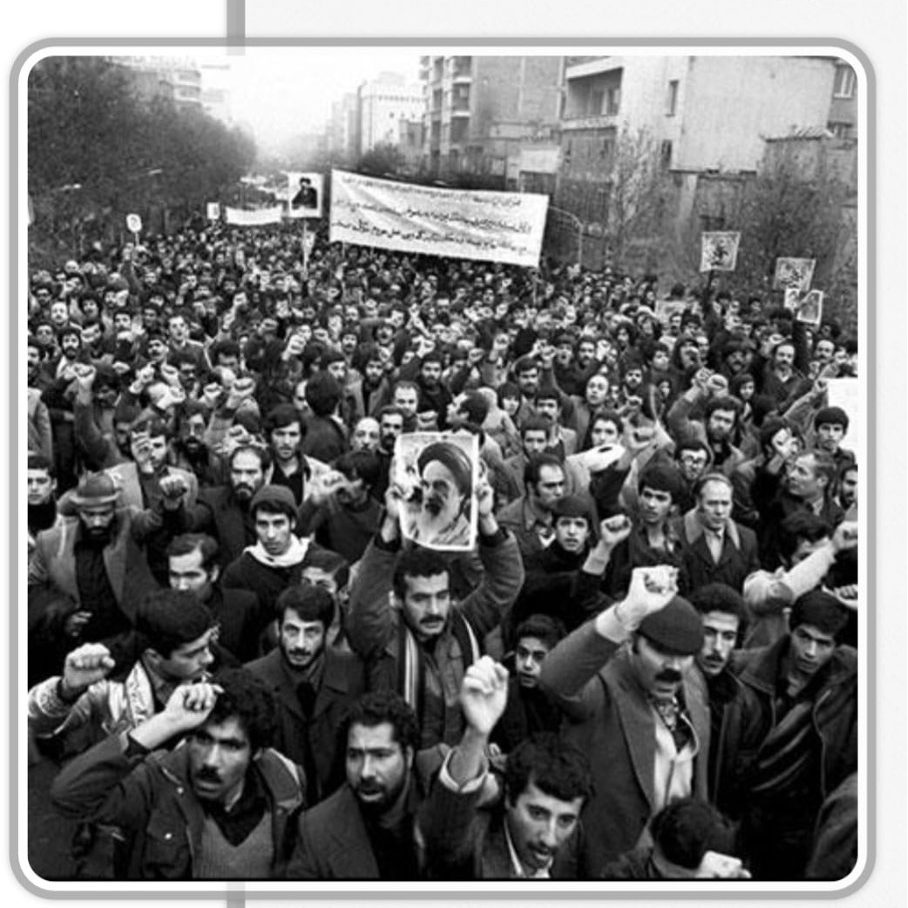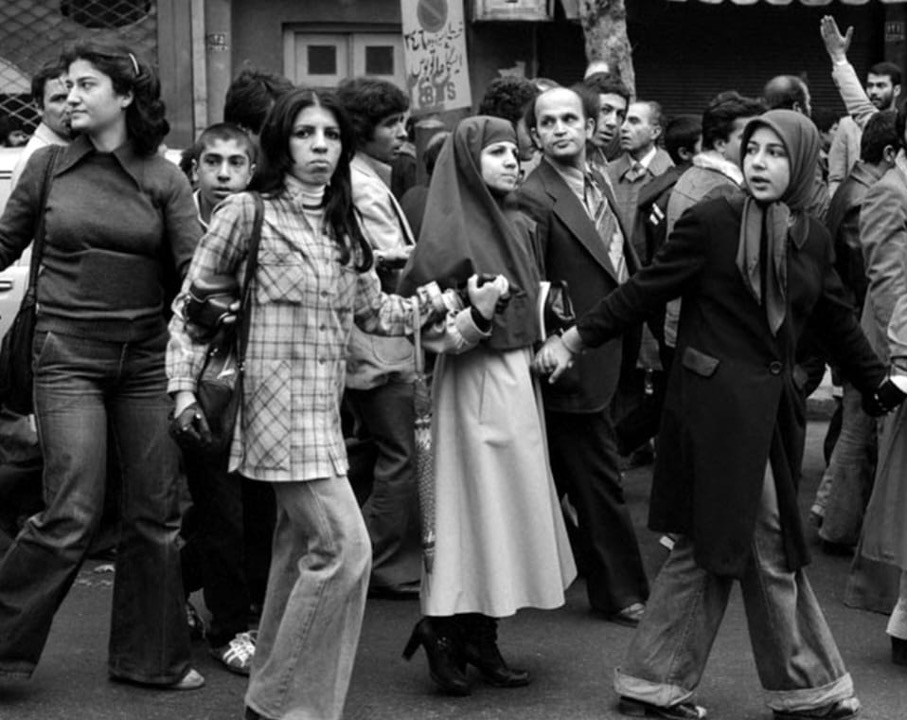
A story based on a half-year research into: ‘to what extent the current protests in Iran resulted from Western Interventions since the twentieth century’.
Espionage, violence, repression, extortion, intimidation and finally the liquidation of Masoud Molavi Vardanjani, an Iranian dissident, who was shot dead on a sidewalk of a street in Istanbul. Tehran’s influence has grown enormously since the founding of the Islamic Republic. For instance, the Iranian government conducts cyber-attacks with some regularity and is the originator of widespread assassination attempts. In addition, the Iranian regime tries to hack the phones and computers of Iranian activists. The regime also controls internet access in Iran.
During protests, the internet in Iran is frequently shut down to prevent the outside world from seeing how things are going there. As a result, Iranians living abroad rarely have contact with friends and family. VPN networks are created by countries worldwide and institutions, including the US State Department, to bypass the regime’s internet control. An Iranian studying in the Netherlands also set up such a VPN network during the protests of late 2022. Due to security reasons, the source remains anonymous: “Since the outbreak of the protests, the regime has made the internet inaccessible. As a result, we are unable to communicate with each other or let the outside world know the seriousness of the situation. I created a VPN from the Netherlands where Iranians in Iran can log in. This allows them to still communicate with each other in a roundabout way and the outside world is informed. In the beginning, a few million Iranians were connected to this VPN network. Unfortunately, the government has made it even more difficult. Together with some friends, I am trying to maintain this network. Currently, about 3.000 Iranians are still connected. It is less than in the beginning, but it all counts”.
The regime has so much power inside and outside Iran. It spreads fear, hatred, and division, but behind the scenes, it is steadily building a network of alliances and international relations. The Revolutionary Guard has gained influence in Iraq, Syria, Lebanon, Afghanistan, and Yemen, thanks to the Quds Force, the part of the Revolutionary Guard that is mainly active abroad. It supports the Shiite majority in Iraq and supplies money and weapons to the, in Western view, terrorist organisations, Hamas and Hezbollah. This is in order to increase its influence in the Arab world and to spread the ideas of the Islamic Republic, but also to stand strong against the West and their ‘archenemy’ Saudi Arabia. Although a deal was recently made between Iran and Saudi Arabia, through China’s mediation, it still must be seen how Israël will respond. Israël, meanwhile, also has friendly relations with Saudi Arabia.
Iran’s foreign policy
To gain more influence, Terrorism is an important tool of Iranian foreign policy. It is used both to promote national interests and to export the regime’s revolutionary ideals. A study that investigated Iran’s foreign and defence policy concluded that the Iranian regime; thus,
-Strives to discourage or thwart US or other attempts to invade, intimidate or bring about regime change in Iran,
-Uses regional conflicts to pursue a broader goal of overthrowing a Middle East power structure, that it claims, favours the United States, Israel, Saudi Arabia, and other Sunni Muslim regimes,
– Provides material support to regional allied governments and armed groups, including increasingly precise missile systems that enable Iran to project power,
-Supports actions against international shipping in the Persian Gulf and Iraq. In addition, the Iranian regime also has people liquidated who oppose the Islamic Republic’s ideology. Some killings even suggested methodical planning. Including the liquidation of Masoud Molavi Vardanjani, the Iranian dissident.
Although Iran is afflicted by a heavy package of Western-imposed sanctions in response to the regime’s foreign policy and approach, the population suffers from the ever-worsening economic and often hopeless situation. The Revolutionary Guards, together with the Quds Force on the other side, only seem to be getting more powerful.
/s3/static.nrc.nl/wp-content/uploads/2016/05/image-2016-05-06.jpg)
Thomas Robert John Erdbrink is a Dutch Journalist. For a long time, he was an Iran correspondent and works for several news channels. Erdbrink lived in Iran for over 25 years and speaks fluent Farsi. For a long time, he was the only Western journalist in Iran. In 2015, the documentary series ‘Our Man in Tehran’ was released. In this series, he highlights the impact of political decisions on the lives of Iranian citizens as no one else can.
According to Erdbrink, in the 20 years, the sanctions have been in place, they have only made the regime richer and the poor poorer: “Sanctions allowed foreign countries to be scapegoated for all domestic problems. It allowed the most extreme groups to grab power and money and only made them richer and more powerful afterwards”. Adding to this, the regime is becoming increasingly radical and is cracking down harder than ever on insurgents. For instance, in a recently published report on the number of executions by 2022 worldwide, Amnesty International concluded that Iran went from 314 to 565 executions in one year. Besides Iran, the US is also on the list of countries that still carry out executions to date. The difference with America is that there, the death penalty is only imposed in cases of extreme violence and after an extensive trial. In addition, in America, far fewer executions are carried out and the accused have the option of choosing an independent lawyer, while in Iran, death sentences are carried out just for participating in demonstrations. This is without due process and the opportunity to choose an independent lawyer. The large rise in the number of executions carried out by the Iranian regime shows a hardening.
Ever since September 2022, people in Iran -as well as in countries around the world- have been taking to the streets to express their dissatisfaction with the regime and the Revolutionary Guard’s crackdown. Iranians are protesting the regime’s strict rules. The strict and numerous rules mean that Iran is also seen as a country where anything goes but nothing is allowed. The main reason behind these large-scale protests is the freedom-restricting rules for Iranian women. One example is the country’s strict dress code, which is controlled by the so-called ‘Moral Police’. The same branch of the regime arrested and mistreated the 22-year-old Iranian Kurdish Jina Masha Amini on 16 September 2022. Masha later died of her injuries in a Tehran hospital. Her death is seen as the trigger behind the protests. Rather, the cause can be traced to the regime’s approach.
Since the founding of the Islamic Republic of Iran in 1979, Iranians have regularly taken to the streets. The occasion varied, but the underlying cause remained the same. The 2008/2009 protests, also known as the ‘Green Movement‘, were primarily a reaction to electoral fraud. In the background, economic malaise, repression, inequality, unemployment, and Iran’s ever-increasing influence in neighbouring Shia countries, through supporting ‘terrorist organisations’, played a role. Although the trigger for the 2018 and 2019 protests was mainly due to the increase in fuel prices, the underlying cause was again reflected in the regime’s approach.
Erdbrink lived in Iran during this period and reported on both protests: “During the 2008 green revolution, I was out on the streets and was able to do a good job as a journalist. I also eventually stated that the revolution had failed. During the 2018 and 2019 protests, it was already much more difficult for me to report. It was difficult to take to the streets as a journalist or a foreigner anyway. You would be arrested after a week and accused of organising the protests because the regime needed scapegoats. Despite this, I also reported from the streets during the 2018 and 2019 protests”.
In Erdbrink’s view, the 2009 protests were initially peaceful, later the regime did act, but not compared to the approach in 2018 and 2019: “During those protests, a lot of violence was used by the regime and many deaths occurred. At least between 200 and 1,500 but the figures are still unclear”.

Carolien Roelants is a Dutch journalist, editor, and writer. Roelants mainly specialises in the Middle East and is considered an expert in that field. As a columnist, Roelants still writes about her field. In the NRC, she contributes to the weekly column Dwars on current developments in the Middle East.
According to Roelants, protests in Iran are not something that emerged only after the Islamic Republic. People took to the streets much earlier in history, for example, during the 1905-1909 constitutional revolution: “The constitutional revolution, which emerged from an economic crisis and plundering of the country by the British and the Russians, is now also called ‘the awakening of the Iranians. The uprising eventually managed to curb the power of Nasar al-Din Shah Qajar (the Qajar dynasty) and a constitution was established. In this constitution, signed by Mozaffar ad-Din Shah Qajar in 1906, women’s rights were included”.
The revolution turned traditional relations upside down, as evidenced by the emancipatory effect on women, among other things. But divisions in Iran returned after the civil war, which lasted from June 1908 to July 1909. Its strategic location and large oil reserves made Iran attractive to international powers such as the United States, Russia, and Britain. Thousands of foreign troops occupied the country, parliament barely functioned anymore, the leaders of the Constitutional Revolution fled, and Iran slowly slipped into chaos. Despite everything, Roelants says those who fought did not lose. “Sixty girls’ schools were founded in Tehran alone during the time of these revolutions. This has ensured that currently in Iran’s universities, women are the largest group among students.”
Later, the character of the protests shifted to a deposition against the regime which made life extremely difficult. The many obstacles Iranian citizens had to deal with, such as the many restrictions and the worsening economic situation, took its toll.
Consequences of Western Interventions
Since the discovery of a large oil field in 1908 and with it the establishment of the Anglo-Persian Oil Company (APOC), now BP, profits from Iranian oil have gone directly to European countries. In 1941, Mohammed Reza, son of Reza Kahn Shah Pahlavi, came to power. He maintained ties with the West and accepted the oil deal. In 1951, Mohammed Mossadeq was democratically elected by the people. During his reign, he nationalised Iranian oil, after which the British MI6 and the US CIA staged a coup in 1953. Britain and the United States of America did not accept the nationalisation of Iranian oil due to self-interests and restored the Shah’s power. Once again, a Western-minded Shah ruled Iran and with this, the Pahlavi dynasty was restored. Also, Amarica’s self-interest was fulfilled.
The 1953 coup sparked a genuine hatred directed against the West among the strict religious mullahs. The Mullahs were not happy with a Western sha who wanted to Westernize Iran. This eventually led to a Mullah named Ruhollah Khomeini who started to utter criticism. In 1941, Khomeini wrote the book, named ‘The Unveiling of Secrets’, directed against Shah Reza’s regime. In 1945, Khomeini was given the title hojjat al-Islam, the second-highest Shia rank. In 1949, Khomeini was dismissed as a lecturer at the University of Qom because of his persistent criticism of the new shah, Mohammed Reza Pahlavi. Despite his dismissal, Khomeini continued to oppose the Shah’s regime. In 1964, he was expelled from Iran because of his persistent criticism. He continued his criticism from exile in Paris.
From his exile, Khomeini patiently watched as Iran slowly became more and more Westernised. With the Shah’s ‘Westernisation’, Khomeini saw how the differences between Iran’s cities and the flatlands were widening. In addition, he also saw religious big landowners suffering under the Shah’s land reform plans. He watched as the Shah, in 1971, celebrated the so-called “2,500th anniversary of the empire” and invited many world leaders, at the expense of the people.

Darius Madjlessi is a Farsi interpreter and a political activist. In 1959, he came to the Netherlands on a study visa. In Iran, he supported Mossadeq and even spent some time in jail for this. At 35, he temporarily returned to Iran.
From the Netherlands, Madjlessi saw how Khomeini gained more and more followers over the years: ” Khomeini had built a huge network, which ran through the mosques in Iran. Together with other opponents of the Shah, they had succeeded in mobilising international media against the Shah’s regime. America and the West were initially hesitant and rather wait and see; they wanted to watch the cat out of the tree first. After all, the Shah was a friend of the West, especially Israel and especially America. In the last few years before the revolution, the West’s attitude towards the Shah was somewhat hesitant and less friendly. This was due to Iran’s leading role within OPEC and the ever-rising price of oil.”
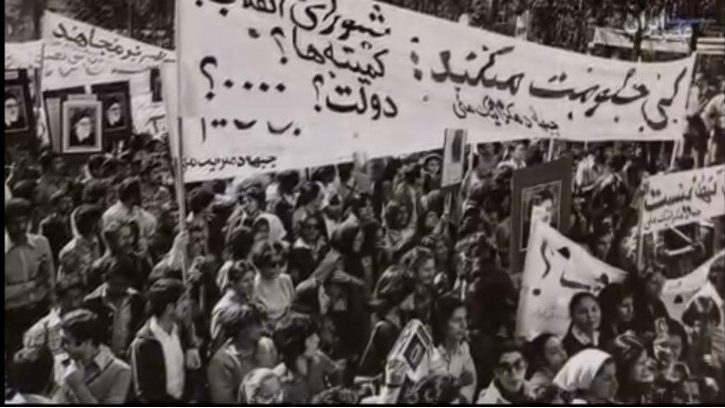
As the years passed, Madjlessi watched how Khomeini solidified his criticisms and the revolution began to emerge: “The Iranian Revolution was all Iranian. Indeed, people could not make the right choice at the right time. Besides, in the case of most revolutions, sentiments play a bigger role than common sense. The Shah was a dictator, and there was no democracy, but when it came to civil liberties, he was a reformer. Women were given voting rights and allowed to be elected. Shapour Bakhtiar called the revolution an “optical error” of the Iranian people. Khomeini additionally promised to allow free elections, free press, and civil and political rights. Iran was divided. Leftist groups in Iran were for a republic and against the monarchy, but also against the Shah’s pro-American policies”.

About one or two months after the revolution broke out in 1978, cooperation began between Madjlessi and Iran’s last prime minister Shapour Bakhtiar. At the invitation of the European Parliament, they went to Strasbourg and addressed the general session of the parliament about the situation in Iran. Madjlessi himself was not active during the revolution. He was, however, sympathetic to Bakhtiar’s ideas. Madjlessi saw how the West tried to de-escalate the situation: “During the revolution, the left and religious took the opportunity, supported by the great masses who had no sense of democracy, by bringing down the Shah. The West decided to seek contact with the revolutionaries and ensure that Western interests remained secure in a future Iran. Revolutionary leaders and Khomeini also sent conciliatory messages to Western leaders to assure them of the pro-Western stance. America even sent a senior military envoy to Iran to ensure that the military in Iran did not take action against the new regime. America was afraid that a new coup would lead to new unrest and instability in one of the most sensitive places in the world”.
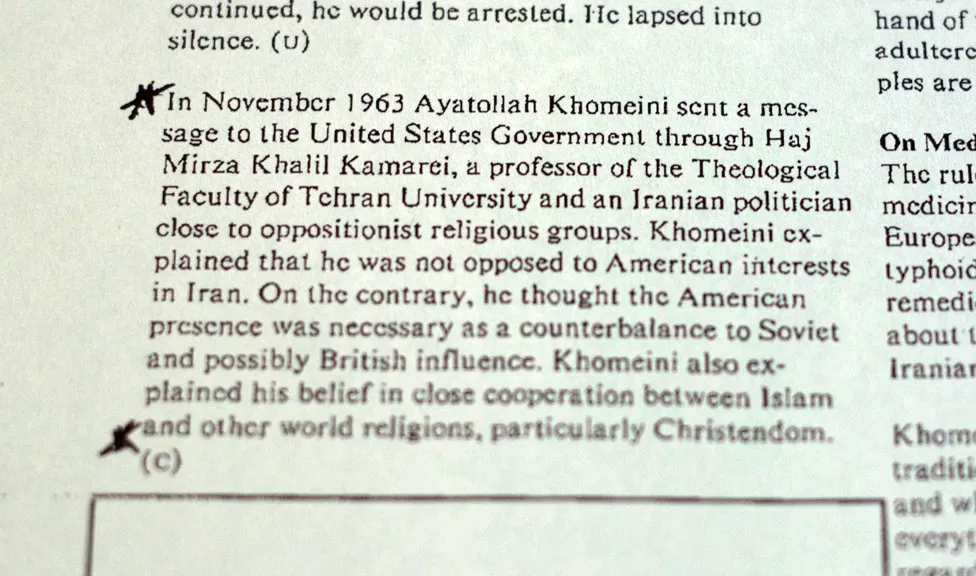
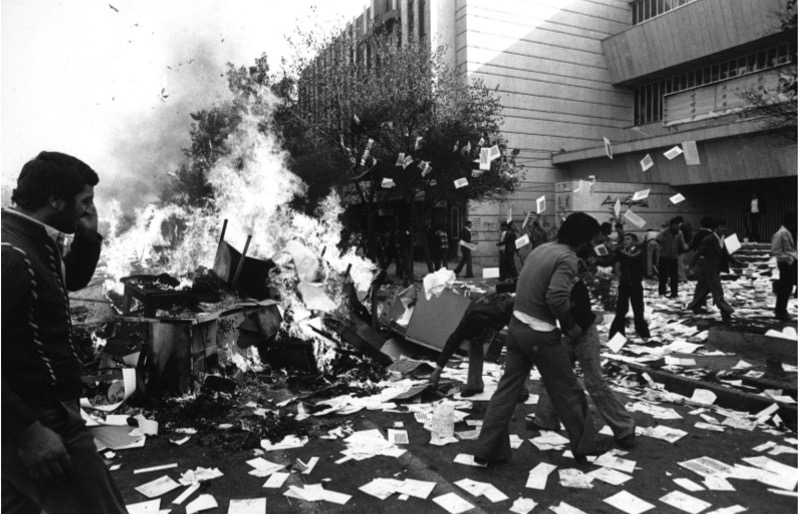
Less than a year later, Khomeini struck a deal with Carter who secured his return to Iran on the first of February 1979. Not entirely unexpected. A recently declassified CIA document reveals that, in November 1963, Khomeini sent a rare message of support to the Kennedy administration while being held under house arrest in Tehran.
After living in exile for 15 years, Khomeini was welcomed as a hero. People had hope and faith in Khomeini. they hoped that he would turn away from the West, and focus on Iran. Khomeini, in his speech given to the people on April 1 1979, promised to establish neither political ties with the East nor the West. Some women took to the streets wearing headscarves to distance themselves from the influence of the West.
According to Madjlessi, Khomeini’s attitude started to change when he came to power: “Once in power, Iran’s attitude towards the West changed and the West was even labelled an archenemy. In addition, nothing came of the promises Khomeini made to the people during the revolution. In particular, Iran’s attitude towards the West manifested itself in hatred towards America and Israel, an attitude that is still regrettable”. In response to years of Western domination and America’s influence, revolutionaries, who eventually hijacked the revolution from the Iranian people, took people in the US embassy in Tehran hostage on 4 November 1979. After 444 days, the hostage situation was ended by the signing of the so-called Algiers Accords. It was done with Western interference. In response, countries in the West and America imposed a heavy package of sanctions. America additionally froze any trade and called a halt to Iranian oil exports. Iran slid further and further into isolation and economic situations continued to deteriorate. As a result, suspicion towards the regime grew.
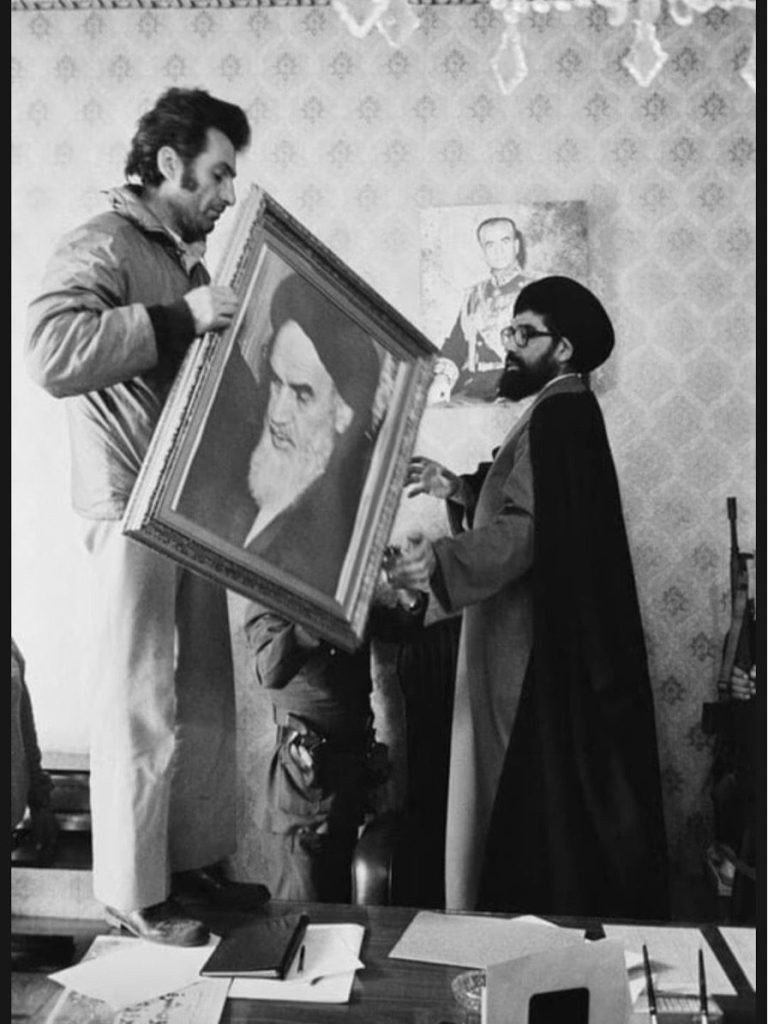
“A lot of Iranians believe that the revolution in Iran was a plot by America. I don’t share that view. The cause of the revolution was largely in Iran itself. Iranians have had no experience of democracy except for the two years during Mossadeq’s reign and about a month during Bakhtiar’s reign during the revolution. A nation that has never had democratic experience finds it difficult to make the right choice at sensitive moments. Unfortunately, the people who had a choice between a Democrat and a cleric during the revolution sided with the cleric. The vast majority of those who made this big mistake then are now against the current regime. With this experience behind us, there is a good chance that, in the long run, democracy will prevail in our country,” Madjessi said.
Power Expansion

In 1980, Iran became embroiled in a war with Iraq. This war lasted eight years and is also known as the First Gulf War. The causes of this war were partly based on territorial disputes and border conflicts. Iraq saw the appearance of the Islamic Revolution in Iran Iraq, as interfering in the internal affairs of Iraq with its Shia population majority. After 1979, Iraqi leader Saddam Hussein, therefore, saw his chance to invade the still shaky Iran, with its large Shiite majority. Hussein expected to invade Tehran easily, but the still-fresh leader Ayatollah Ruhollah Khomeini managed to raise his army from 100,000 men to 200,000 in no time. The war with Iraq is also known for the many child soldiers deployed by the Iranian army. Many died and families were torn apart.
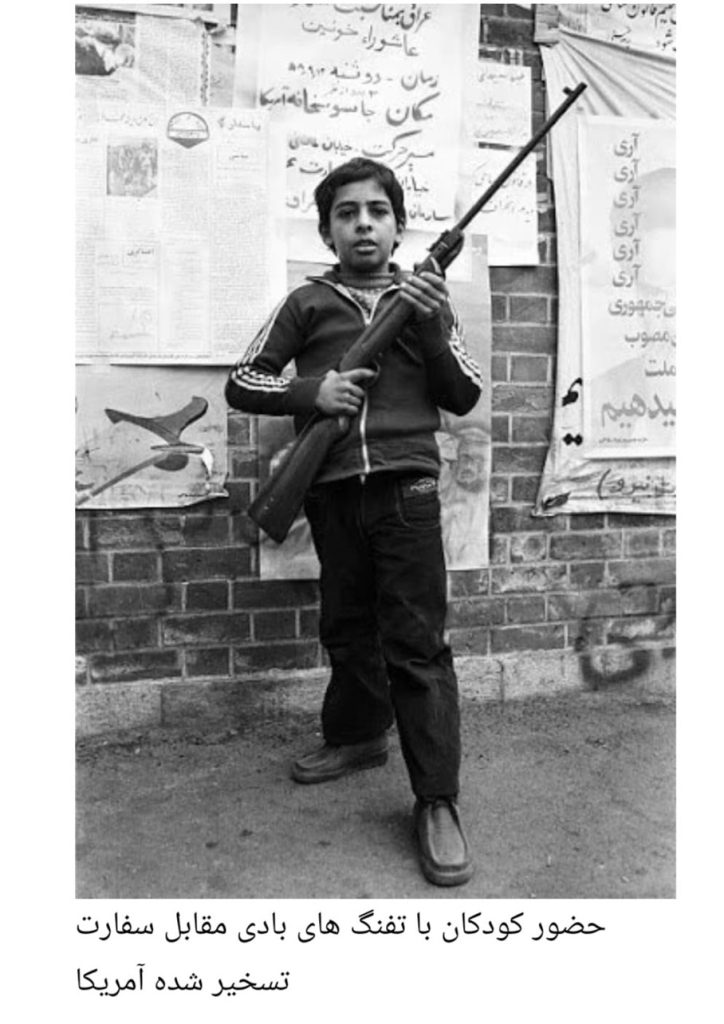
Instead of the expected quick end, Iraq became involved in a war with Iran until 1988. During the war with Iraq, Tehran had signed an arms deal with the US. Iran had to free hostage Americans in exchange for weapons it could use in the war with Iraq. With the proceeds of this arms deal, delivered through Israel, the Reagan administration funded the anti-Sandinista contras in Nicaragua. This event is also known as the Iran Contra affair.

Nikolaos van Dam is a former ambassador and Arabist. Van Dam also worked as a diplomat in the occupied Palestinian territories, Jordan, Lebanon and Libya.
According to van Dam, America’s attitude during this deal is “rather” questionable: “Before the first Gulf War, America was an ally of Iraq. At this time, America had no problem with Iraq using chemical weapons against Iran and against the Kurds at home. In the years after the Iraq-Iran war ended and the US no longer felt it needed Iraq as a buffer against Iran, the US-Iraq relationship deteriorated. It reached its depth with the US-British occupation of Iraq in 2003. US troops invaded Iraq under the false pretence that Iraq possessed weapons of mass destruction. Afterwards, this turned out not to be the case at all. In fact, America rolled out the red carpet for Iran with the occupation of Iraq, allowing Iran to greatly increase its influence in the entire region. For me, America’s stance in the first Gulf War illustrates America’s double standards. To its own citizens, it is a democracy, but to several other countries in the world, the US is perceived as a terrorist state, which has little regard for democracy elsewhere in the world when it is strategically convenient for the US. These are particular countries where the US has intervened militarily”.
According to Middle East expert Paul Aarts, the invasion not only destroyed Iraq, but it increased Iran’s power: “Particularly through the invasion of Iraq, Iran was able to increase its power in the Middle East. Thus, it steadily worked on a network of alliances and international relations. This network of international relations allows Iran to exercise a lot of power to this day. It also tries to control fugitive Iranians abroad. Iran’s power is felt everywhere”.
After the war with Iraq, Iran worked steadily and undisturbed on a network of alliances. The Quds Force began training soldiers in neighbouring countries, such as Syria. This was to increase its influence and demarcate its territory. In addition to a network of alliances, Iran also started enriching uranium again and gathering knowledge to produce nuclear weapons. This despite having already agreed with the West in 1970 to stop developing nuclear weapons. These agreements were set out in the so-called non-proliferation treaty. After 1979, Iran remained an official member, but the Iranian government secretly pursued the development of this nuclear weapons technology. In 2007, US intelligence concluded that Iran had stopped its work on nuclear weapons in 2003 but continued to generate and process nuclear technology and expertise.
An agreement was then reached in 2015 after years of negotiations between Iran and the P5+1. The agreements were set out in the Joint Comprehensive Plan of Action (JCPOA). According to van Dam, America’s double standards are also reflected in its attitude towards Iran regarding the development of nuclear energy: “In the West, Iran is almost by definition bad, because of the Islamic Revolution and what is associated with nuclear energy. This while when allies of the West do similar things, it is seen very differently or not at all. For instance, much fuss is made about Iran’s development of nuclear energy, while Israel, which has a very extensive nuclear arsenal, is usually not mentioned at all. This while that it potentially poses a great danger to the region, if not also to the world beyond. Israel has introduced nuclear weapons to the Middle East, rejecting previous initiatives to achieve a mass destruction weapons-free zone. Israel wants to retain a monopoly over the possession of nuclear weapons in the region and therefore refuses to sign the Nuclear Non-Proliferation Treaty.”
The agreement remained in place for as many as three whole years and things seemed to improve in terms of ties between Iran and the West. Iran was given more space to act because there were agreements in the accord that America and the West would lift sanctions. According to Erdbrink, Iran, ironically, entered a better period: “When sanctions were lifted, prosperity increased for a lot of people in Iran. In addition, Iran was suddenly in contact with foreign countries in which the state’s excuse of blaming foreign countries for all its problems also disappeared. More responsibility suddenly had to be taken by the regime”.
The impact of sanctions
In 2018, President Donald Trump withdrew from the accord and the nuclear deal fell apart. Trump reimposed sanctions right away, despite the IAEA showing that Iran followed the accord. However, during the re-imposed sanctions, Iran did start violating the accord and continued to accumulate knowledge about nuclear energy. According to Madjlessi, a group of hardliners within the regime were not at all happy about blowing off the sanctions from the start: “They tried all sorts of things to prevent an agreement. Internationally, but also nationally, the pressure was too great to reach an agreement. The regime was not at all happy with booming trade and relations with the West. The hardliners preferred not to allow Western potters to witness gross human rights abuses in Iran at close quarters. On top of this, many regime cadres were earning richly from illegal trade and smuggling, something that is not easily possible with an open economy and trade.”
As Trump walked out of the deal, the economic situation worsened. The regime increasingly faced a rebellious population. According to Roelants, sanctions should not be immediately resorted because of the knock-on effects. She wrote in her article titled ‘Sanctions, sanctions, shall we try something else?’ the following: “Nowadays sanctions are automatically resorted to, at least against unfriendly regimes. Many of these sanctions often do not work, are wrong or backfire. I give you Trump and Iran. The US president, in 2018, stepped out of the nuclear deal that the Iranians had complied with up to that point, according to IAEA inspectors, and then, in his Trumpian way, announced the “toughest sanctions ever” in order to reach a better (not retrofitted or edited) agreement.”The campaign of “maximum pressure”, by contrast, led to a counter-campaign of “maximum resistance”.
After the sanctions were declared, Tehran hardened. It increasingly violated the nuclear deal in the eyes of America, which had also drafted the agreement. The population was weighed down by an increasingly severe and hopeless situation. Indeed, also because of the regime’s economic and other mismanagement. Energy, transport, and financial sanctions imposed on top of the mismanagement and the already economically desperate situation had a disastrous effect on the population. “The sanctions had much less impact on the regime, which over the years has accumulated shortcuts to get out from under sanctions. It is of course completely hypothetical, but where would Iran be today if Trump had not stepped out of the agreement?”, Roelants said.
According to Erdbrink, Sanctions have been one of the most impactful forms of Western interventions. “Sanctions have had more impact than the 1953 coup or CIA interference. Those sanctions are the most important thing. I think historically we can look back on those sanctions as a period where those sanctions actually gave more power to the men in power and in the process also made Iran’s foreign policy more extreme.”Because sanctions mainly affect Iranians, the economic situation only gets worse. This situation mostly leads to discontentment. A discontentment where the flame could flare up at any moment.
To suppress discontent, the Revolutionary Guards acted increasingly harshly. Under General Qasem Soleimani, the Quds Force generated more and more power and territory. Until on 3 January, the US killed Soleimani in a terrorist-planned drone attack. In response, the Revolutionary Guards became more aggressive, and Iran increasingly Traded with China and Russia. Because of Western-imposed sanctions that made any kind of trade with Iran impossible, Iran was in this sense forced to trade with Russia and China. For instance, Iran supplies drones to Russia and Russia also recently launched an Iranian satellite. According to Roelants, the West’s sanctions have thrown Iran into the lap of China and Russia. “Russian President Putin recently ‘cosied up’ to the Iranian supreme leader,”. A US State Department spokesman signalled on the satellite that Russia and Iran are ‘deepening their alliance’. In addition, Moscow promises to invest hundreds of millions of euros in Iran.”
Iran’s attitude towards Russia and China is additionally dubious. It is dubious considering Ayatollah Khomeini promised the public after the founding of the Islamic Republic not to trade with the East as well as the West. The imposed sanctions make it impossible for Iran to fulfil this promise. But whether Russia will invest In Iran and continue to trade remains to be seen. Indeed, according to Roelants, Putin has no problem today with Israeli planes and drones bombing Iranian targets in Syria on an ongoing basis. According to Roelants, Putin is not going to invest hundreds of millions at all: ” On the contrary, he is in the process of hijacking Iran’s only major oil customer China by offering higher discounts than Tehran is offering. But if sanctions are imposed, Iran will continue to look eastwards. The people will continue to suffer from this until things change”. The relationship between Iran and Russia is something the whole world should look at. It is a relationship that should be seen as a serious threat.
Since the outbreak of war in Ukraine on 24 February 2022, Iran has been supplying so-called kamikaze drones to Russia, which are then used to launch attacks on Ukrainian territory. As the war progressed, Iran switched to supplying military props. Most recently, French Prime Minister Macron called on Iran to stop trading with Russia. As Iran trades with Russia and China, thereby in a way perpetuating the war in Ukraine, an even tougher package of sanctions was imposed. Again, the Iranian economy fared badly, and the ‘ordinary’ people were affected. Dissatisfaction grew among the population and more and more people took to the streets.
The flame literally caught fire when Jina Masha Amini died after her arrest by the morality police. For a moment, the whole world stood in solidarity with Iranian women. Headscarves were burned and women cut off their hair. For a moment, the 2022 protests seemed to bring about change. For a moment there was hope, but the religious leaders tolerated no dissent and slammed any protest harshly.
Change
Despite the regime’s crackdown, a new wind seems to be blowing among some religious leaders. For instance, there are discussions among politicians about reforms and more rights for Iranian women. The street scene in Iran has also changed after the 2022 protest wave. More people are increasingly daring to lower their headscarves and let their hair blow. Whether the protests will lead to harsh reforms remains to be seen. However, support for ‘democracy’ has been growing among Iranians in recent years. However, many Iranians want to see change, it is and will remain a long-term thing. Although the protests did not initially lead to the overthrow of the regime, discussions about reforms are increasingly emerging among religious leaders.

According to Madjlessi, change must come from within and no ‘regime change’ should be brought about. “We have seen often enough in history what happens when a regime is toppled from the outside. The opposite is often achieved. In addition, Iran has not had a democratic upbringing, which means there is very little support. However, Iran does have an increasingly civil society, partly due to social media. Iran has widely educated people, including many women. The moment discussions within the regime become larger, there is a good chance that this will lead to positive reforms.” Erdbrink also agreed ” The government should not be overthrown by force from outside. It is a form of wishful thinking that will sort of solve this problem all at once. Besides, there are three major examples in the region where all this has led to drama. Namely Afghanistan, Iraq, and Libya. A government overthrown from outside to push through reforms is the last thing that should be done to Iranians as well.” According to Erdbrink, any unnatural form of progress leads to regression.
Besides, things are already moving in the right direction in Iran. For instance, Iranian women are increasingly lowering their headscarves. Where the state used to determine what you could and could not say in public spaces, this has now been reduced to just access to banks and other government institutions. In addition, Iran’s senior leaders will soon come of age to pass away. The question is whether the dictatorship will disappear with them. What remains is that Iranians, despite all the oppression, have already brought about these changes.
Because of the regime’s great power, the long arm of Tehran‘ continues to be felt all over the world. Therefore, it remains to be seen whether the armed ruler, the Islamic Revolutionary Guard Corps, will give up its power. It is also questionable whether the revolutionary guard will stay away permanently, or whether it will soon be back on the street again. Besides this, Iran still leaves a trail of fear, intimidation, repression cyber-attacks and espionage to this day.
Literature
All ‘old’ photos are from the photo book titled: Revolution 1978 through the camera of Zhjll Peres
Afary, J. (2023, 7 juli). Iranian Revolution | Summary, Causes, Effects, & Facts. Encyclopedia Britannica. https://www.britannica.com/event/Iranian-Revolution
Algiers Agreement | 1975, Iran-Iraq. (z.d.). Encyclopedia Britannica. https://www.britannica.com/topic/Algiers-Agreement
Alston, A. N. (2021, 8 januari). Conservative, rebellious, culture-defining: A brief history of the headscarf. CNN. https://edition.cnn.com/style/article/headscarf-brief-history/index.html
Alterman, J. B. (2022). Protest, social media, and censorship in Iran. www.csis.org. https://www.csis.org/analysis/protest-social-media-and-censorship-iran
Andringa, R. (2019, 8 januari). De verhalen achter de liquidaties van de twee Iraniërs in Nederland. NOS. https://nos.nl/artikel/2266648-de-verhalen-achter-de-liquidaties-van-de-twee-iraniers-in-nederland
Ayatollah Ruhollah Khomeini, Address to the Nation, April 1, 1979. (1979, 1 april). National Security Archive. https://nsarchive.gwu.edu/document/28043-document-03-ayatollah-ruhollah-khomeini-address-nation-april-1-1979
BBC News. (2020, 3 januari). Qasem Soleimani: US kills top Iranian general in Baghdad air strike. BBC News. https://www.bbc.com/news/world-middle-east-50979463
Bergman, R., & Fassihi, F. (2020, 18 september). Iranian hackers can beat encrypted apps like Telegram, researchers say. The New York Times. https://www.nytimes.com/2020/09/18/world/middleeast/iran-hacking-encryption.html
Carmichael, E. B., & Anderson, Q. (2021). The First Gulf War: Operations Desert Shield and Desert Storm (17 January-28 February 1991). British Dental Journal, 230(7), 435–443. https://doi.org/10.1038/s41415-021-2733-5
Dabashi, H. (2013, 12 juni). What happened to the green movement in Iran? Opinions | Al Jazeera. https://www.aljazeera.com/opinions/2013/6/12/what-happened-to-the-green-movement-in-iran/
Doodstraf 2022: hoogste aantal executies in 5 jaar. (2023, 4 juli). Amnesty International. https://www.amnesty.nl/actueel/doodstraf-2022-hoogste-aantal-executies-in-5-jaar
Encyclopaedia Iranica Foundation. (z.d.). Welcome to Encyclopaedia Iranica. https://www.iranicaonline.org/articles/anglo-persian-oil-company
Engelbrecht, C., & Fassihi, F. (2022, 5 december). What to know about Iran’s morality Police. The New York Times. https://www.nytimes.com/2022/12/05/world/middleeast/iran-morality-police.html
Euronews. (2023, 28 april). How Iranians are hopping between VPNs to stay connected and break through internet censorship. euronews. https://www.euronews.com/next/2022/11/06/iran-protests-vpn-use-soars-as-citizens-seek-way-around-internet-censorship
Fattahi, B. K. (2016, 3 juni). Two weeks in January: America’s secret engagement with Khomeini. BBC News. https://www.bbc.com/news/world-us-canada-36431160
Golkar, S., & Aarabi, K. (2023, 28 april). The real motivation behind Iran’s China-brokered deal with Saudi Arabia. Foreign Policy. https://foreignpolicy.com/2023/04/06/iran-saudi-arabia-deal-agreement-china-meeting-beijing/
Guyer, J. (2022, 24 september). How the death of 22-year-old Mahsa Amini has galvanized Iran’s protesters. Vox. https://www.vox.com/world/2022/9/24/23368595/iran-women-burning-hijabs-mahsa-amini
Hardie, J., & Taleblu, B. B. (2022, 26 oktober). Iran is now at war with Ukraine. Foreign Policy. https://foreignpolicy.com/2022/10/26/iran-ukraine-russia-war-drones-missiles-military-advisors-middle-east-nuclear/
History of Iran: Constitutional Revolution. (z.d.). https://www.iranchamber.com/history/constitutional_revolution/constitutional_revolution.php
Hojjat al-Islam | Encyclopedia.com. (z.d.). https://www.encyclopedia.com/religion/encyclopedias-almanacs-transcripts-and-maps/hojjat-al-islam
How the Iran hostage crisis shaped the US approach to sanctions | Brookings. (2022, 9 maart). Brookings. https://www.brookings.edu/articles/how-the-iran-hostage-crisis-shaped-the-us-approach-to-sanctions/
Iran. (2019). Human Rights Watch. https://www.hrw.org/world-report/2019/country-chapters/iran
Iran – the World Factbook. (z.d.). https://www.cia.gov/the-world-factbook/countries/iran/
Iran hostage crisis – Definition, results & facts. (2010, 1 juni). HISTORY. https://www.history.com/topics/middle-east/iran-hostage-crisis
Iran sanctions – United States Department of State. (2023, 2 juni). United States Department of State. https://www.state.gov/iran-sanctions/
Iran’s growing presence in Syria’s al-Hasakah poses a direct threat to US forces. (z.d.). Middle East Institute. https://www.mei.edu/publications/irans-growing-presence-syrias-al-hasakah-poses-direct-threat-us-forces
Iran’s networks of influence in the Middle East | New IISS dossier. (z.d.). IISS. https://www.iiss.org/publications/strategic-dossiers/iran-dossier
Jelle van Buuren discusses the long arm of Tehran on Dutch television. (2020, 13 juli). Leiden University. https://www.universiteitleiden.nl/en/news/2020/07/jelle-van-buuren-discusses-the-long-arm-of-tehran-on-dutch-television
Jensen, K., & Klunder, M. (z.d.). Saddam Hussein’s grand strategy during the Iran-Iraq War. In DTIC. https://apps.dtic.mil/sti/citations/ADA441658
Kashfi, E. (2021). The Politics of Calendars: state appropriations of the contested Iranian past. Religions, 12(10), 861. https://doi.org/10.3390/rel12100861
Landler, M. (2021, 6 april). Trump abandons Iran nuclear deal he long scorned. The New York Times. https://www.nytimes.com/2018/05/08/world/middleeast/trump-iran-nuclear-deal.html
Litovkin, N. (2023). Russia unveils new kamikaze drone armada (Photos). Russia Beyond. https://www.rbth.com/science-and-tech/334174-russia-unveils-new-kamikaze-drone
Menafn. (2023, 19 mei). Iran executes 3 men linked to 2022 anti-govt protests. Middle East North Africa Financial Network. https://menafn.com/1106277206/Iran-Executes-3-Men-Linked-To-2022-Anti-Govt-Protests
Motamedi, M. (2023, 11 maart). What to expect after Iran, Saudi Arabia agree to restore ties. News | Al Jazeera. https://www.aljazeera.com/news/2023/3/11/what-to-expect-after-iran-saudi-arabia-agree-to-restore-ties
Najdi, Y., Gholami, N., Deedar, O., & Neufeld, D. (2022, 7 december). Jina Mahsa Amini: The face of Iran’s protests. dw.com. https://www.dw.com/en/jina-mahsa-amini-the-face-of-irans-protests/a-64007550
NOS. (2023, 19 januari). Machtige Revolutionaire Garde mogelijk op terreurlijst: “Verdere isolatie van Iran”. NOS. https://nos.nl/artikel/2460406-machtige-revolutionaire-garde-mogelijk-op-terreurlijst-verdere-isolatie-van-iran
Others, F. B. A. (2022, 10 mei). 1953 Coup in Iran | Coup d’’Etat, description & facts. Encyclopedia Britannica. https://www.britannica.com/event/1953-coup-in-Iran
Protesters across the world stand in solidarity with Iranian women. (2022, 10 oktober). [Video]. euronews. https://www.euronews.com/video/2022/10/10/protesters-across-the-world-stand-in-solidarity-with-iranian-women
Regencia, T. (2019, 1 februari). 40 years on: Khomeini’s return from exile and the Iran Revolution. News | Al Jazeera. https://www.aljazeera.com/news/2019/2/1/40-years-on-khomeinis-return-from-exile-and-the-iran-revolution
Report: Iran accelerates cyberattacks. (2023, 3 mei). The Iran Primer. https://iranprimer.usip.org/blog/2023/may/03/report-iran-accelerates-cyberattacks
Robinson, K. (2023, 21 juni). What is the Iran nuclear deal? Council on Foreign Relations. https://www.cfr.org/backgrounder/what-iran-nuclear-deal
Sharhani, Y. (2023, 4 mei). Wat is de Iraanse invloed in Nederland? NPO Kennis. https://npokennis.nl/story/265/wat-is-de-iraanse-invloed-in-nederland
Stilwell, B. (2023). The horrifying way Iran used kids to clear mines. We Are The Mighty. https://www.wearethemighty.com/mighty-history/iran-iraq-war-child-soldiers-mines/
The Editors of Encyclopaedia Britannica. (2023a, juni 1). Quds Force | Meaning, History, & Facts. Encyclopedia Britannica. https://www.britannica.com/topic/Quds-Force
The Editors of Encyclopaedia Britannica. (2023b, juni 12). Mohammad Mosaddegh | Biography & Facts. Encyclopedia Britannica. https://www.britannica.com/biography/Mohammad-Mosaddegh
The Editors of Encyclopaedia Britannica. (2023c, juli 5). Ruhollah Khomeini | Biography, Exile, Revolution, & Facts. Encyclopedia Britannica. https://www.britannica.com/biography/Ruhollah-Khomeini
The Editors of Encyclopaedia Britannica. (2023d, juli 6). Iran-Iraq War | Causes, Summary, Casualties, & Facts. Encyclopedia Britannica. https://www.britannica.com/event/Iran-Iraq-War
The IAEA and the Non-proliferation Treaty. (z.d.). https://www.iaea.org/topics/non-proliferation-treaty
Timeline: Iran’s foreign plots and assassinations. (2023, 30 juni). The Iran Primer. https://iranprimer.usip.org/blog/2020/sep/16/timeline-iran-assassinations-and-plot
Twaij, A. (2022, 15 september). Iraq is on the brink of a Shiite civil war between al-Sadr and Iran. Foreign Policy. https://foreignpolicy.com/2022/09/15/iraq-sadr-iran-shiite-civil-war/
Wikipedia-bijdragers. (2022). Mohammad Reza Pahlavi. Wikipedia. https://nl.wikipedia.org/wiki/Mohammad_Reza_Pahlavi
Writer, S. (2017, 24 januari). Iranian Revolutionary Guards Corps gets increased power – Iran Focus. Iran Focus. https://iranfocus.com/economy/31178-iranian-revolutionary-guards-corps-gets-increased-power/
کسرایی, م. (2004, 21 mei). از انقلاب سفید تا انقلاب اسلامی. https://matin.ri-khomeini.ac.ir/article_66066.html
